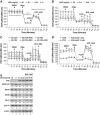Erratum to: Co-regulation of mitochondrial respiration by proline dehydrogenase/oxidase and succinate
- PMID: 26874699
- PMCID: PMC4969956
- DOI: 10.1007/s00726-016-2184-5
Erratum to: Co-regulation of mitochondrial respiration by proline dehydrogenase/oxidase and succinate
Figures

Erratum for
-
Co-regulation of mitochondrial respiration by proline dehydrogenase/oxidase and succinate.Amino Acids. 2016 Mar;48(3):859-872. doi: 10.1007/s00726-015-2134-7. Epub 2015 Dec 10. Amino Acids. 2016. PMID: 26660760 Free PMC article.
Publication types
LinkOut - more resources
Full Text Sources
Other Literature Sources

